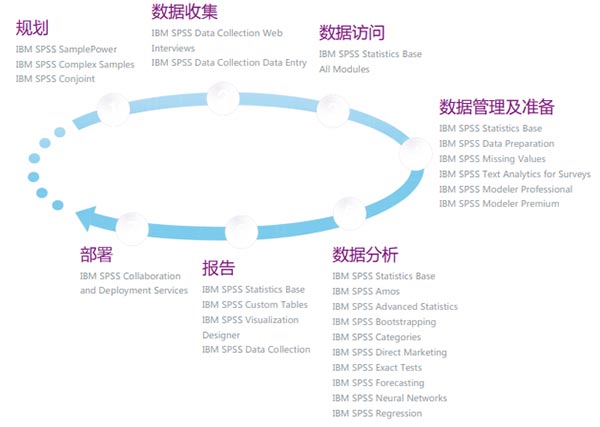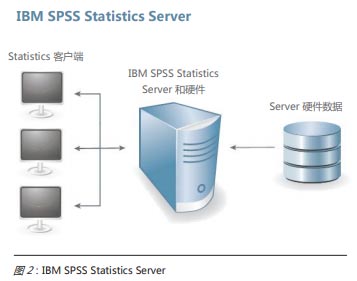
ibm spss statistics 26Also known as spss26, it is the world's leading statistical analysis, data mining, and predictive modeling products and solutions, providing advanced statistical analysis, rich machine learning algorithms, text analysis, open source scalability, integration with big data, and seamless deployment into applications. It is easy to use, flexible, and scalable, and can provide services for users with various skill levels. It helps you and your business discover new opportunities, improve efficiency, and minimize risks, providing the core driving force for artificial intelligence transformation for enterprises.
IBM SPSS Statistics 26 now supports the entire analytical process. This product helps people validate hypotheses more quickly, guiding them to use the right statistical functions at the right time. It also provides analysts of all skill levels with flexible access to powerful analytical techniques. With SPSS 26, companies can streamline their data analysis and reporting processes. Analysts no longer need to use multiple tools and resources; they can work within a single, integrated product suite, simplifying the work of analysts and managers while also reducing the workload for enterprise technical support staff.
Compared with previous versions, SPSS 26.0 software has added many new features that bring many desirable new statistical tests, enhancements to existing statistical and scripting programs, and new production facility functions to the Classic user interface. For example, the features and functions of the IBM SPSS Statistics product portfolio and many of its specialized modules have been enhanced; the new ROC procedure can more easily evaluate the accuracy and performance of predictive classification models; the Bayesian statistical program suite has been enhanced; reliability analysis has been enhanced; many other analysis procedures and new command enhancements have been introduced to better improve user efficiency.

Software Advantages
1. Comprehensive statistical tools
Work in an all-in-one, integrated interface to run descriptive statistics, regression analysis, advanced statistics, and more. Create publication-ready charts, tables, and decision trees in a single tool.
2. Easily perform statistical analysis
Use a simple drag-and-drop interface to access functionality and work across multiple data sources. Plus, flexible deployment options make it easy to purchase and manage the software.
4. Integration with open source
Enhance SPSS Syntax with R and Python through specialized extensions. Use over 130 extensions in the Extension Center, or build your own and share them with your peers to create personalized solutions.
Software Highlights
1. Multiple key function interfaces allow you to flexibly use in-depth analysis capabilities.
IBM spss statistics 26 gives analysts of all skill levels flexible access to powerful analytical techniques. the software offers a variety of interfaces to key features, from a menu-driven user interface experience for novices to command syntax and programmable extensibility for experienced statisticians.
2. Comprehensive statistical tools allow you to use the right statistical functions at the right time.
SPSS Statistics 26 helps people test and validate hypotheses more quickly, uncover additional information efficiently, and use the right statistical function at the right time. The SPSS Statistics product family offers the most comprehensive tools for the entire analytical process. With easy access to multiple data types and numerous integrated modules, analysts can obtain the necessary information for the task at hand. The software's reporting and deployment capabilities also provide users with insights and enable them to communicate results more quickly and clearly.

3. Multiple deployment functions help you make full use of statistical resources.
Because it easily scales to meet the needs of any organization, from individual end users to entire departments or enterprises, SPSS Statistics helps organizations make the most of their analytical resources.

Our statistical software can be purchased individually or in three editions: IBM SPSS Statistics Standard, IBM SPSS Statistics Professional, and IBM SPSS Statistics Premium. These editions bring together essential features to provide an efficient way to ensure your entire team or department has the capabilities they need to perform the analyses that drive business success.
SPSS Statistics achieves this flexibility by supporting a variety of deployment options – from a standalone desktop application for individuals to multi-client/server deployments for large teams of analysts. Users can also benefit from the content management, automation, and deployment capabilities of IBM SPSS Collaboration and Deployment Services.
SPSS26 new features and enhancements:
1. Quantile regression
In standard "least squares" regression, model predictions are based on a single regression line. This line can be used to estimate the mean of the dependent variable, represented by the clustering of points along the line at given values of the independent (predictor) variables.
2. ROC analysis
The new ROC procedure makes it easier to evaluate the accuracy and performance of predictive classification models. ROC (Receiver Operator Characteristic) analysis focuses specifically on a model's classification accuracy, specifically the relationship between accurate classifications (called true positives and true negatives) and inaccurate predictions (false positives and false negatives). This is typically represented by an ROC curve, which plots the true positive rate (TPR) against the false positive rate (FPR) at different threshold settings. The new ROC analysis procedure also includes precision-recall (PR) curves and offers the option to compare two ROC curves generated from independent groups or paired subjects.
3. Bayesian Statistics
SPSS Statistics 26 also includes enhancements to its suite of Bayesian statistical procedures.
4. One-way repeated measures ANOVA
Repeated measures augmentation allows analysts to take a Bayesian approach to comparing any change in a given factor across different time points or conditions for the same subject, assuming that each subject has one observation at each time point.
5. One Sample Binomial Enhancement
Here, users can apply a Bayesian binomial test to try to determine the likelihood that the observed ratio between two groups is the same as the hypothesized proportion in the population.
6. One Sample Poisson Boosting
Same as the previous procedure, except here the user can compare their data to how well it fits a Poisson distribution. These distributions are useful for modeling rare events such as accidents or insurance claims. When drawing Bayesian statistical inference on a Poisson distribution, a conjugate prior within the Gamma distribution family is used.
7. Reliability analysis
Several additional enhancements have been made to the reliability routines in SPSS Statistics. Reliability analysis has been updated to include an option for Fleiss's Multiple Rater Kappa statistic. This technique is often employed when assessing the reliability of agreement between a fixed number of raters, when assigning categorical ratings to multiple items or when categorizing items. This contrasts with other kappa statistics, such as Cohen's kappa, which are only applicable to estimates of agreement between a maximum of two raters.
8. Procedure and Script Improvements, SPSS Statistics 26 includes several enhancements to existing procedures and script commands so you can apply richer analysis to your data.



